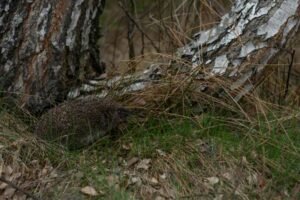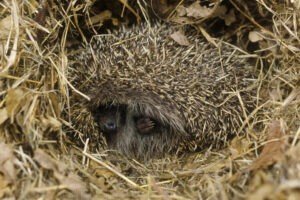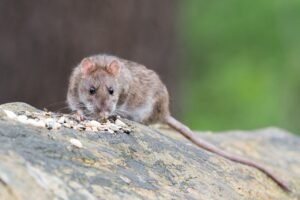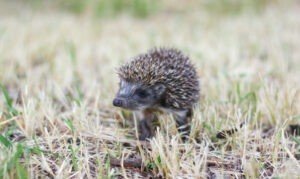In order to feed hedgehogs, not rats, you must create an environment that is primarily conducive to a hedgehog’s lifestyle. This includes creating a clean, natural environment that hedgehogs can find plenty of their own food — and using feeding practices that limit the chances of attracting rats.
Attracting hedgehogs to a yard or garden space is a fine hobby, and can be rewarding if done correctly. I personally find a sense of satisfaction seeing a local hedgehog in my yard scrounging about in the night hours, looking for food in some bushes or the more leafy parts of my yard’s edges.
That being said, I understand that attracting hedgehogs to my yard is essentially attracting a wild animal to human space. This leaves open the possibility that I attract unwanted animals like rats there, too. This is something I want to avoid — especially if my yard provides food for hedgehogs.
So I want to make sure that I feed hedgehogs, not rats — when it comes to my yard. I have done a little research and trial-and-error with this issue, and the best answer seems to be to a combination of providing a hedgehog-friendly feeding environment and using rat-deterrent feeding practices.
Overview
We are essentially talking about two classes of animals when it comes to rats and hedgehogs. The hedgehog most common in the UK is the European Hedgehog (_ERINACEUS EUROPAEUS, _but we’ll refer to them as “hedgehogs”) and has its own behavioral patterns and abilities when it comes to feeding.
When we refer to rats, we are likely talking about either Brown rats (RATTUS NORVEGICUS) or Black rats (RATTUS RATTUS). Though the rats are different in size (the brown rat is slightly larger than the black rat), they have similar feeding behaviors and foraging patterns.
About Hedgehogs
Hedgehogs are nocturnal creatures that can move between two or three kilometers nightly looking for food. They make nests during the day, inhabiting and sleeping in areas of hedges, shrubs, and low-lying brush.
Wild hedgehogs feed on a variety of foods and are considered omnivorous. They are, however, partial to invertebrates, with upwards of fifty percent of their diets devoted to earthworms, caterpillars, and beetles.

In addition to this, wild hedgehogs will eat a variety of other invertebrate foods such as millipedes, pill millipedes, earwigs, slugs, snails, and insect larvae. Their vertebrate foods consist mainly of carrion, which they scavenge — such as dead birds, hatchlings, frogs, toads, and small mammals.
Hedgehogs will eat ground bird eggs if they happen upon a nest. They will also eat some fruit — they have been known to gnaw on discarded apples and strawberries. Their consumption of small twigs, bark, moss, and leaves appears to be incidental.
Hedgehogs eat different foods at different points of the year. Though they enjoy earthworms year-round, they eat earwigs, caterpillars, leatherjackets, beetles, slugs, and millipedes from August to October. Their interest in caterpillars, leather jackets, and beetles is revived in March and April.
Hedgehogs go through hibernation during the winter months, starting in October/November and finishing in either March or April. During this time, a hedgehog’s metabolic rate reduces dramatically, as they conserve energy from quantities of food they’ve eaten in late summer and early fall.
Hedgehogs can, however, be seen wandering about during hibernation months. This is normal, and for this reason, some people in residential areas like to provide supplemental sources of food for them in this period.
About Rats
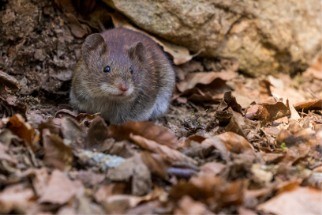
Black and brown rats are both nocturnal creatures. When it comes to the times of night when they are most active, it is considered to be about a half-hour after sunset and about a half-hour before sunrise.
Though they are more agile than hedgehogs — being able to climb over moderately-sized fences, crawl through 0.6 centimeter-diameter holes, dig vast tunnel systems, and climb sheer straight metal poles — rats will only travel about 100 to 300 feet from their nests to look for food each night.
However, during harvest times in rural areas, rats will travel much longer distances to look for discarded maize, beans, and wheat. This behavior may be emulated in cities or suburbs where garbage is more plentiful and there is a better opportunity to feed.
A rat’s favorite food appears to be cereal grain, but it will also eat meat, milk, vegetables, snails, fruit, candy, eggs, poultry, seeds, nuts, birdseed, dog feces, fish, leather, soap, garbage, fur, carrion, grass seed, spoiled food, and other rodents. A rat is able to eat up to a third of its body weight each day.
Rats are also hoarding creatures that keep caches of food in certain areas. This is a health risk, as these caches can attract insect pests. Rats are carriers of fleas and disease-carrying biting insects, and an individual rat can create well over 20,000 droppings a year.
Making Your Garden Ideal For Hedgehogs
Given the health implications of a rat population anywhere near your home, there is no way to overemphasize the importance of finding ways to feed hedgehogs, not rats, in your backyard.
Fortunately for garden and yard owners along the hedgehog highway, there are practical ways to feed hedgehogs that do not involve directly giving them food. This includes creating areas of brush and plants that would propagate the natural foods that hedgehogs eat.
For example, surface-dwelling earthworms (also known as EPIGEIC EARTHWORMS) tend to eat decaying leaves and organic matter. Knowing this, you can plant hedges, bushes, or shrubs — you will have a consistent supply of dead or fallen leaves.
Also, putting your garden weeds, dead leaves, and yard trimmings in a designated pile may improve the chances of surface earthworms inhabiting the area. Large rocks or logs on your lawn may also provide a good natural habitat for several invertebrate species underneath, including earthworms.

If you want to make your pile of organic yard matter more attractive to earthworms, lightly water and aerate the pile occasionally by using a pitchfork and do not turn the pile. You can also lightly aerate the surrounding soil using a pitchfork, too.
You will want to avoid putting discarded human foods in a compost heap – this will only attract rats. If you have to keep a compost heap, try to make one from the natural materials already in your yard. Just make sure to keep the heap at a manageable level, and look out for potential rat nests.
Plant some flowers that will attract butterflies, or better yet, grow plants that caterpillars love to eat. These include nettles, thistles, holly, ivy, dog rose, nasturtiums, hops, willows, hawthorns, and blackthorns, among others.
Plants that attract insects include crocus, sedum, snapdragons, marjoram, summer lilac, geraniums, and lavender, among others. A densely planted garden would provide enough under-leaf areas for beetles and moist decaying areas for millipedes, two of a hedgehog’s favorite foods.
Using Rat-Deterrent Feeding Practices
No products found.
If you feel that you have to feed your hedgehogs using store-bought foods, choose dry or wet foods that are hedgehog-specific (sold in stores). If this is not possible, dry or wet cat food (without fish or gravy) is ideal.
You will want to use a heavy, shallow tray to serve hedgehogs this food – and another similar tray for freshwater. You will want to feed your hedgehog well into the night if you can, away from the pre-dawn/dusk waking hours of rats.
No products found.
Put the trays of food and water out in the middle of an open area of your garden (rats do not favor open areas). Keep an eye on these trays to see when the hedgehogs go to eat the food. When the hedgehog is finished, step back outside and remove the trays and clean up any dropped food.
Make sure you keep and store your hedgehog food (whatever it may be) in secure containers in a clean indoor area. To protect against rats, this means using containers of solid metal or hard glass construction.
Keeping Rats Away For Good
The best way to avoid rats is to avoid putting human foods — fresh or spoiled — in outside areas where hedgehogs are likely to be. Garbage, compost scraps from human sources, cat or dog foods, picnic foods, or snacks — should be kept well away from your backyard or garden.
If you really want to get a better chance of seeing a hedgehog from something you put outside, try a shallow dish of water in your yard. This can be put out nightly or simply left outside.
No products found.
In addition to this, you might want to use mint to deter rats, they do not seem to like it. Sprinkling peppermint oil around the yard and growing garden mint plants are good ways to slow rat encroachment.
A neighborhood cat or cats might deter rats as well — and they are not likely to bother hedgehogs. You might want to consult with your neighbors about this.
In terms of your backyard construction, avoid covering up hedgehog holes, for this will inhibit hedgehog foraging. Besides this, rats can often scale backyard walls anyway.
Finally, do not use rat poison, herbicides, or pesticides around hedgehog areas. All of these materials are extremely harmful and can be fatal to hedgehogs.
Conclusion
Feeding hedgehogs is a little counterintuitive. Though I was originally ready to feed hedgehogs myself (and yes, I will occasionally do so at times), I’ve realized that this can attract rats if not done properly. So I always take extra care when I do.
Overall, though, I’ve found the best way to feed hedgehogs — and not rats — is to create better soil environments for worms and allow for the natural flourishment of insect-attracting plants. In addition to this, I like to put a little tray of water out when I can.
In these ways, I can minimize disruption, slow down any rat encroachment, and see the benefits of a natural environment for the overall health of my garden — and this includes hedgehogs as well.
Last update on 2023-07-31 / Affiliate links / Images from Amazon Product Advertising API


